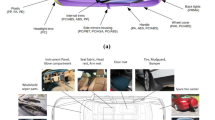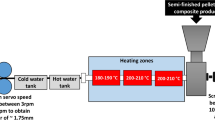Abstract
Automobile industries are focusing toward the reduction in the weight of vehicle that leading to cost reduction and improving the fuel efficiency. Polymers are the main alternatives in conventional engineering materials for automobile components due to their advanced mechanical and thermal properties. This article is mainly focused on the ultrasonic welding of polypropylene and PC-ABS materials followed by thermal analysis of injection-molded and welded specimens. The materials are examined by an advanced analysis method called differential scanning calorimetry. The crystalline nature of the material is changed (area varies from 95.1 to 115.4 J g−1) at injection-molded regions in polypropylene differential scanning calorimetric results. After polypropylene welding, the glass transition temperature values tend to change from 5 to 10 K min−1 heating ranges. In PC-ABS blend, the glass transition temperature is changed from 126.3 to 127.0 °C in the non-welded material. From the welded PC-ABS material results, it is evident that the difference between 5 and 10 K min−1 heating value is only 1.8 °C. Finally, the finite element analysis is carried out to examine the materials deformation pattern with temperature loading.













Similar content being viewed by others
References
Thakur VK, Vennerberg D, Kessler MR. Green aqueous surface modification of polypropylene for novel polymer nanocomposites. ACS Appl Mater. 2014;6:9349–56.
Yazdi MH, Pearl LS. Determination of dual glass transition temperatures of a PC/ABS blend using two TMA modes. J Therm Anal Calorim. 2009;96(1):7–14.
Suresh KS, Roopa Rani M, Prakasan K, Rudramoorthy R. Modeling of temperature distribution in ultrasonic welding of thermoplastics for various joint designs. J Mater Process Technol. 2007;186(1):138–46.
Schawe JEK. Influence of processing conditions on polymer crystallization measured by fast scanning DSC. J Therm Anal Calorim. 2014;116(3):1165–73.
Thompson JL, Van Rooyen AA. Transcrystallized interphase in thermoplastic composites, Part I: influence of fiber type and crystallization temperature. J Mater Sci. 1992;27(4):889–96.
Farhanian Sajed. Mehdi H. Thermal and morphological aspects of silver decorated halloysite reinforced polypropylene nanocomposites. J Therm Anal Calorim. 2017;130(3):2069–78.
Sohn JI, Lim ST, Park SH, Choi HJ, Jhon MS. Effect of a reactive-type flame retardant on rheological and mechanical properties of PC/ABS blends. J Mater Sci. 2003;38:1485–91.
Tsujino J, Hongoh M, Tanaka R, Onoguchi R, Ueoka T. Ultrasonic plastic welding using fundamental and higher frequencies. Ultrasonics. 2002;40:375–8.
Benatar A, Cheng Z. Ultrasonic welding of thermoplastics in the far field. Polym Eng Sci. 1989;29(23):1699–704.
Kim SR, Lee JH, Yoo CD, Song JY, Lee SS. Design of highly uniform spool and bar horns for ultrasonic bonding. In: IEEE transactions on ultrasonics, ferroelectrics, and frequency control. 2011; 58(10).
Saboktakin AA, Ibarra-Castanedo C, Bendada AH, Maldague X. Finite element analysis of heat generation in ultrasonic thermography. In Proceedings of QIRT. 2011; pp. 619–24.
Ageorges C, Ye L, Hou M. Advances in fusion bonding techniques for joining thermoplastic matrix composite. Compos Appl Sci Manuf. 2001;32:839–57.
Wang J, Mao QC, Chen JN. Preparation of polypropylene single-polymer composites by injection molding. J Appl Polym Sci. 2013;130(3):2176–83.
Golebiewski Jan. Andrzej G. Thermal stability of nanoclay polypropylene composites by simultaneous DSC and TGA. Compos Sci Technol. 2007;67(15):3442–7.
Basalp D, Tihminlioğlu F. The effects of natural zeolite and silane coupling agents on melting and crystallization behaviour of polypropylene. J Therm Anal Calorim. 2008;94(3):757–65.
Luo J, Liang Y, Yang J, Niu H, Dong JY, Han CC. Mechanisms of nucleation and crystal growth in a nascent isotactic polypropylene/poly (ethylene-co-octene) in-reactor alloy investigated by temperature-resolved synchrotron SAXS and DSC methods. Polymer. 2011;52(20):4590–9.
Wunderlich B. Reversible crystallization and the rigid–amorphous phase in semicrystalline macromolecules. Prog Polym Sci. 2003;28(3):383–450.
Kulinski Z, Piorkowska E. Crystallization, structure and properties of plasticized poly (L-lactide). Polymer. 2005;46(23):10290–300.
Suarez H, Barlow JW, Paul DR. Mechanical properties of ABS/polycarbonate blends. J Appl Polym Sci. 1984;29(11):3253–9.
Benatar A, Eswaran RV, Nayar SK. Ultrasonic welding of thermoplastics in the near-field. Polym Eng Sci. 1989;29(23):1689–98.
Shieu F-S, Bo-Hua W. On the microstructure and tensile strength of PC/ABS polymer blend joints. J Polym Res. 1995;2(4):263–7.
Troughton, M J. Handbook of plastics joining: a practical guide. William Andrew. 2008.
Varga J. Supermolecular structure of isotactic polypropylene. J Mater Sci. 1992;27(10):2557–79.
Rybiński Przemysław, Grażyna J. Effect of the spatial network structure and cross-link density of diene rubbers on their thermal stability and fire hazard. J Therm Anal Calorim. 2014;117(1):377–86.
Greco R, Maria FA, Lisong D, Sorrentino A. Polycarbonate/ABS blends: processability, thermal properties, and mechanical and impact behavior. Adv Polym Technol. 1994;13(4):259–74.
Parres F, Balart R, López R, García D. Changes in the mechanical and thermal properties of high impact polystyrene (HIPS) in the presence of low polypropylene (PP) contents. J Mater Sci. 2008;43(9):3203–9.
Romano RS, Grecco WLO, Duclerc FP, Ademar BL. Accelerated environmental degradation of gamma irradiated polypropylene and thermal analysis. J Therm Anal Calorim. 2018;131(1):823–828.
Teixeira M, Del Hoyo I, Wandrowelsti F, Swinka-Filho V, Munaro M. Evaluation of thermal degradation in isotactic polypropylene films used in power capacitors. J Therm Anal Calorim. 2017;130(2):997–1002.
Li Bo, Runlai L, Xongxin X. Properties and effect of preparation method of thermally conductive polypropylene/aluminum oxide composite. J Mater Sci. 2017;52(5):2524–33.
Haghighi Y, Mojtaba PL, Ali M. Specific heat capacity of polycarbonate/acrylonitrile–butadiene–styrene (PC/ABS) blend after hygrothermal aging. J Therm Anal Calorim. 2017;130(3):2105–11.
Chiang W-Y, Gwo-Long T. Effect of the compatibilizers on flame-retardant polycarbonate (PC)/acrylonitrile–butadiene–styrene (ABS) alloy. J Appl Polym Sci. 1997;65(4):795–805.
Aid S, Anissa E, Zaida O, Daniel F, Abbas T. Experimental study of the miscibility of ABS/PC polymer blends and investigation of the processing effect. J Appl Polym Sci. 2017; 134 (25).
Nigam I, Nigam D, Mathur GN. Effect of rubber content of ABS on properties of PC/ABS blends. I. Rheological, mechanical, and thermal properties. Polym-Plastics Technol Eng. 2005;44(5):815–32.
Rostami Amir, Mohsen M, Mohammad JF, Mehdi V. Role of multiwalled carbon nanotubes (MWCNTs) on rheological, thermal and electrical properties of PC/ABS blend. RSC. Advances. 2015;5(41):32880–90.
Krache Rachida, Ismahane D. Some mechanical and thermal properties of PC/ABS blends. Mater Sci Appl. 2011;2(5):404.
Thuong, Nguyen T, Nguyen DM, Phuong Q, Bui T, Long GB. Preparation and Characterization of Properties of Acrylonitrile Butadiene Styrene Waste Plastic Blended with Virgin Styrene Butadiene Rubber. In Key Engineering Materials. 2017; 718: 3–9.
Zhong Y, Umeyr K, Heow PL. Prediction of the mechanical behavior of flax polypropylene composites based on multi-scale finite element analysis. J Mater Sci. 2017;52(9):4957–67.
Lambiase F, Genna S, Kant R. A procedure for calibration and validation of FE modelling of laser-assisted metal to polymer direct joining. Opt Laser Technol. 2018;98:363–72.
Lionetto Francesca, Riccardo DA, Francesco M, Alfonso M. Modeling of continuous ultrasonic impregnation and consolidation of thermoplastic matrix composites. Compos A Appl Sci Manuf. 2016;82:119–29.
Funding
The author(s) received no financial support for the research, authorship and/or publication of this article.
Author information
Authors and Affiliations
Corresponding author
Ethics declarations
Conflict of interest
The author(s) declared no potential conflicts of interest with respect to the research, authorship and/or publication of this article.
Rights and permissions
About this article
Cite this article
Chinnadurai, T., Prabaharan, N., Raj, N.M. et al. Ultrasonically welded and non-welded polypropylene and PC-ABS blend thermal analysis. J Therm Anal Calorim 132, 1813–1824 (2018). https://doi.org/10.1007/s10973-018-7052-y
Received:
Accepted:
Published:
Issue Date:
DOI: https://doi.org/10.1007/s10973-018-7052-y




